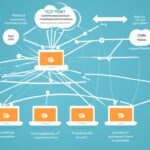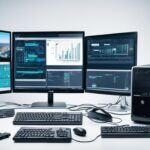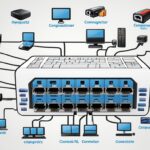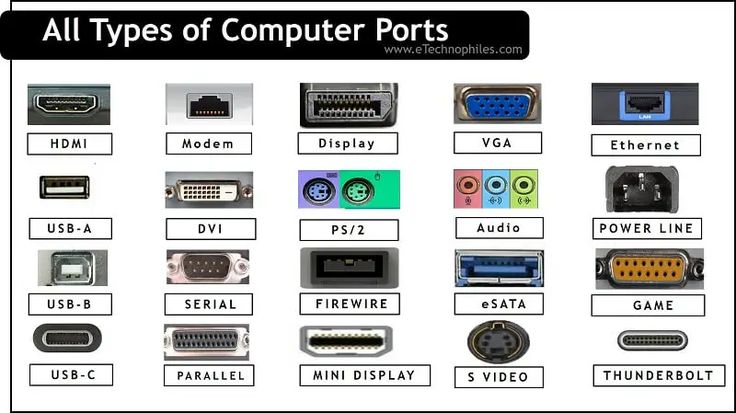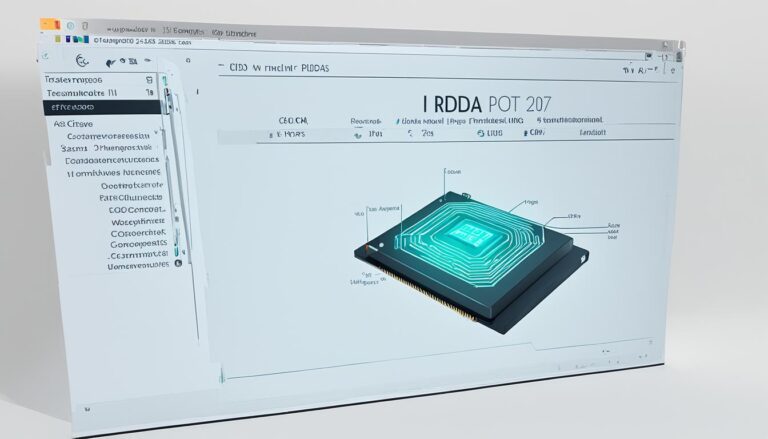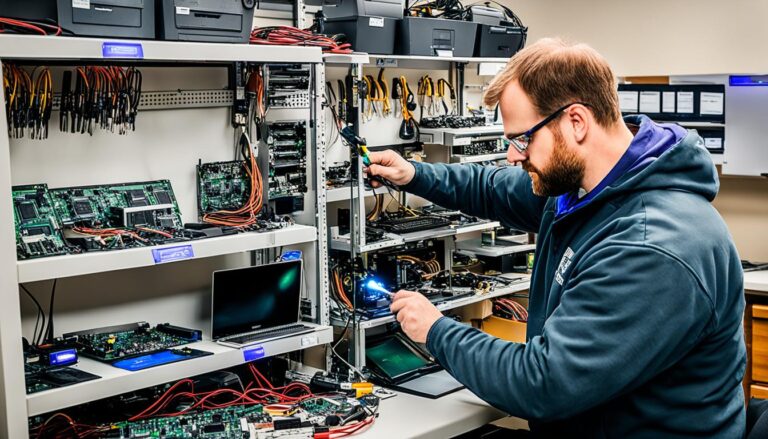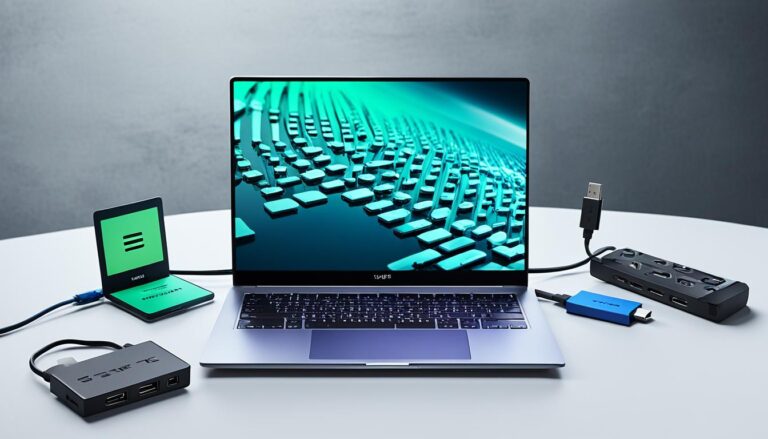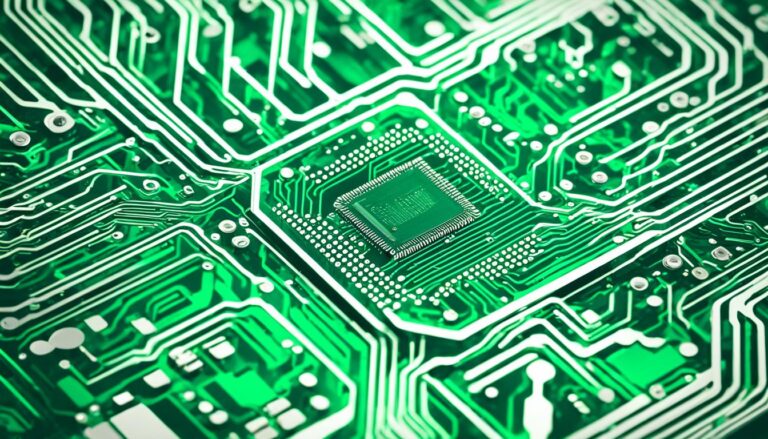Computer ports, also known as porta del computer in Italian, are key in tech. They allow devices to share data and talk to each other. This makes everything work together smoothly.
In Italian tech, knowing about computer ports is crucial. It’s important for handling devices, networking, or dealing with websites. With this knowledge, everything runs better, and you can sort out issues faster.
We’re about to dive into the world of computer ports in Italy. We’ll look at different types, like TCP and UDP ports. We’ll see how they’re used in networks and on the internet.
Common TCP and UDP Ports for Serial-to-Ethernet Device Servers
Serial-to-Ethernet device servers connect serial devices to Ethernet networks. They enable devices to communicate and transfer data smoothly. These devices use certain TCP and UDP ports for their functions. Knowing these ports is key to their successful operation in technology setups.
Below is a list of the main TCP and UDP ports used by these servers:
TCP Ports
- Port 80: This port is for HTTP communications, making it possible for servers to connect and share data online.
- Port 443: This port secures HTTPS communications. It encrypts and authenticates data for better security.
- Port 502: Linked with Modbus, Port 502 lets servers talk to Modbus devices. It’s used in industrial automation.
- Port 23: The Telnet port, Port 23, offers remote access and control over servers via a Telnet client.
UDP Ports
- Port 161: For SNMP, Port 161 enables servers to get info and monitor network devices.
- Port 514: Linked with syslog, Port 514 allows servers to send logs for analysis and problem-solving.
- Port 69: Known as the TFTP port, Port 69 simplifies file transfers between servers.
Note that these port numbers might change based on the manufacturer and the specific needs of the application. When you’re setting up these servers, picking the right TCP and UDP ports is critical. It ensures smooth connectivity and top performance.
For a visual guide of the common TCP and UDP ports used, see the table below:
| TCP Ports | UDP Ports |
|---|---|
| Port 80 | Port 161 |
| Port 443 | Port 514 |
| Port 502 | Port 69 |
| Port 23 |
It’s vital to understand and set up the TCP and UDP ports for serial-to-Ethernet device servers. Correct port settings ensure reliable, secure communication in networks. With the right setup, businesses can maximize the benefits of serial-to-Ethernet device servers across various fields and applications.
TCP and UDP Ports for Networking and Web Interfaces
In the Italian tech industry, TCP and UDP ports are crucial for networking and web interfaces. They play a key role in connecting devices and letting data flow.
Common TCP Ports for Networking and Web Interfaces
TCP (Transmission Control Protocol) ensures reliable, connection-focussed communication. Here are the key TCP ports used:
| Port Number | Service |
|---|---|
| 80 | HTTP (Hypertext Transfer Protocol) |
| 443 | HTTPS (HTTP Secure) |
| 22 | SSH (Secure Shell) |
| 23 | TELNET |
| 25 | SMTP (Simple Mail Transfer Protocol) |
Common UDP Ports for Networking and Web Interfaces
UDP (User Datagram Protocol) is perfect for quick applications. Here are the commonly used UDP ports:
| Port Number | Service |
|---|---|
| 53 | DNS (Domain Name System) |
| 67 | DHCP (Dynamic Host Configuration Protocol) Server |
| 68 | DHCP (Dynamic Host Configuration Protocol) Client |
| 161 | SNMP (Simple Network Management Protocol) |
| 162 | SNMP Trap |
These TCP and UDP ports ensure smooth communication for web interfaces and devices. IT pros, developers, and network admins in Italy need to know them for a seamless experience.
To keep networks safe, it’s vital to manage these ports well. Using strong firewall rules and updating security policies often are good practices.
Urban Regeneration and Port Redevelopment in Italy
Urban regeneration and port redevelopment are key for improving Italian ports. This involves looking closely at each port’s needs. For the Canal Port of Rimini, a plan was made after inspections and studies. The plan is to enhance services, access, and the area’s urban quality. It will reconnect paths, upgrade quays, and create new spaces for everyone. These changes aim to lift the area’s life quality and economic health.
Italy’s ports, rich in history, have seen wear over the years. Regeneration and redevelopment are now essential. They turn old ports into lively centers of activity. The Canal Port of Rimini on Italy’s east coast is undergoing such a transformation. Its location and growth potential make it a prime candidate for redevelopment.
Italy’s investment in urban regeneration aims to revive overlooked areas for better economic growth. The Canal Port of Rimini project shows how enhancing a port’s function and look can improve the urban setting too. These projects are great for local people and help draw in both investment and tourists. This boosts the area’s economic health.
For the Canal Port of Rimini, several goals have been set:
- Reconnecting paths for walking and biking to improve access and encourage green transport.
- Upgrading quays to better serve ships and for leisure activities.
- Creating lively public areas for locals and visitors to enjoy.
This project supports sustainable urban growth. It seeks a good balance between economic progress, caring for the environment, and making sure everyone benefits.
Benefits of Urban Regeneration and Port Redevelopment
The Canal Port of Rimini’s regeneration brings many advantages to locals and the wider area:
| Benefit | Description |
|---|---|
| Economic revitalization | This project draws investment, creates jobs, and stimulates local economic activity. |
| Tourism promotion | It makes the port a top spot for tourists, which helps local businesses and brings in money. |
| Improved quality of life | People’s living conditions get better thanks to nicer urban areas and upgraded facilities. |
| Sustainable development | It focuses on green strategies, like encouraging biking and reducing the environmental footprint, for a healthier port area. |
Italy’s regeneration and redevelopment projects do more than just improve ports. They also breathe new life into the nearby urban areas. The Canal Port of Rimini represents an effective, sustainable model for urban growth. It merges economic expansion with social and environmental goodness. By revitalizing its ports, Italy is leading the way in fostering prosperous coastal communities and a dynamic maritime sector.
Benefits of Urban Regeneration in Canal Port Area
Canal Port’s urban regeneration brings many advantages to locals and the wider area. It revives neglected urban settings, lifting neighbourhoods and spurring economic growth. Let’s look at some key benefits urban regeneration introduces to Canal Port:
Enhanced Infrastructure and Connectivity
The Canal Port’s rejuvenation projects aim to improve infrastructure and connectivity. They build better roads and public transport, making the area more accessible. They also improve the digital network, ensuring the Canal Port can support new business and innovation.
Revitalized Economy
Urban regeneration in Canal Port kick-starts the local economy. It brings new businesses, creating jobs and driving growth. The area’s revival attracts investors, boosts tourism, and supports local entrepreneurs. This leads to a strong and sustainable economy.
“Urban regeneration has the power to transform declining areas into vibrant communities, attracting both residents and businesses.” – Jane Green, Urban Development Expert
Improved Quality of Life
Regenerating Canal Port focuses on creating places for everyone to enjoy. Parks, promenades, and waterfronts offer recreation and promote social connection. These changes improve community life quality. Urban regeneration also embraces eco-friendly designs, making neighbourhoods healthier.
Cultural and Heritage Preservation
Keeping Canal Port’s heritage and culture is a key part of urban regeneration. The projects protect and revitalise important landmarks and spaces. They balance tradition with the new, building community pride and a bond with the city’s past.
Urban regeneration in Canal Port signifies beneficial change. It nurtures vibrant, inclusive communities and boosts economic success. These initiatives change the cityscape and enrich the lives of people who live or visit here.
Virtual Reality for Urban Planning and Streetscape Assessment
Virtual reality (VR) is becoming essential in urban planning and design. It lets us visualise and test different planning ideas in a 3D space. Planners and designers use it to share their visions, work with stakeholders, and improve the planning process.
Using VR, planners create virtual worlds that turn ideas into something you can see and explore. This helps everyone understand innovations better and gets them involved. When people see projects in detail, they appreciate urban planning more.
VR is great for looking at streetscapes. It lets planners see how new buildings or roads might change an area. They can look at how people move around, what the area will look like, and if it meets the community’s needs. Using data, planners can make streetscapes that are lively, nice to live in, and good for the planet.
“Virtual reality enhances the urban planning process by providing a realistic and immersive way to assess proposed designs. It allows us to engage stakeholders, collect valuable feedback, and make informed decisions that shape the future of our cities.”
VR also helps more people have a say in planning. It gives virtual tours so people from different places can join in, even if they can’t be there in person. This brings everyone’s ideas together and helps make places that fit the community’s wishes.
Case Study: The Regeneration of Market Square
The Market Square’s makeover shows VR’s power in planning. Planners made a detailed VR model of the square. This let people explore various designs in a 3D space.
This VR model showed how the square could change, looking at lights, trees, and places to sit. Walking through the space, people gave feedback that helped shape the square’s future.
VR made planning for Market Square more together and welcoming. The final design took everyone’s views into account. It made the square a happy place, keeping its history while serving today’s needs.
| Benefits of Virtual Reality in Urban Planning and Streetscape Assessment |
|---|
| 1. Enhanced visualization and understanding of proposed projects |
| 2. Improved stakeholder engagement and participation |
| 3. Inclusive decision-making processes |
| 4. More accurate assessment of streetscape impacts |
| 5. Design optimization and cost savings in the planning phase |
VR is pushing urban planning into a new era of creativity and effectiveness. As cities grow, VR will be key in designing urban spaces. It helps everyone involved work together, ensuring decisions make cities sustainable, inclusive, and lively.
The Role of Computer-Aided Design and Virtual Reality in Urban Planning
Computer-aided design (CAD) and virtual reality (VR) have changed urban planning. CAD lets architects make detailed 3D models. VR lets users explore and interact with these models. These technologies help in better decision-making and improve communication among all involved. By using CAD and VR, cities can become more efficient and better places to live.
Enhancing the Design Process
CAD is key in improving urban planning designs. It allows for the creation of accurate 3D models. These models show designs clearly and help spot potential problems early. Being able to change views aids in refining designs, ensuring they are functional and beautiful. CAD makes changes easy, saving time and effort.
Collaborative Decision-Making
VR brings a new level to working together in urban planning. It lets people see designs in a virtual world. This gives a realistic view, helping to understand and judge the project’s effects. With VR, everyone can offer feedback and help shape decisions. This method results in plans that consider everyone’s views.
Improved Communication
Good communication is crucial in urban planning. CAD and VR help everyone understand each other better. CAD creates visuals that everyone can understand, beyond complex terms. VR lets people experience designs directly. This helps everyone, technical or not, to share a common vision. Good communication improves teamwork in planning.
Transforming Cities into Efficient and Sustainable Spaces
Using CAD and VR can make cities better and greener. They let us see and fix problems before building begins. VR can test different setups and see their effects on energy, transport, and nature. This careful planning leads to smart choices for a sustainable city.
CAD and VR assist urban planners in dealing with complex planning, improve decision-making, and bring about cities that are good for the future.
Conclusion
Understanding computer ports is key in Italy’s tech world. These ports are vital for data transfer and communication between devices. Knowing the different types makes it easier to use technology.
Also, improving Italian ports is crucial for their looks, use, and economy. The Canal Port in Rimini shows how valuable these projects are. By meeting specific needs and making better spaces, the port now offers more services and a nicer place for everyone.
Finally, virtual reality (VR) has become very useful in planning cities. With VR, people can see new projects in 3D before they’re built. This helps everyone talk better, join in, and make choices together. By using VR and computer design, Italy is staying ahead in tech and city development.
FAQ
What are computer ports in the Italian tech context?
In Italy, “porta del computer” means computer ports. They are key for electronic devices. They allow data to move and components to talk to each other.
What are the common TCP and UDP ports for serial-to-Ethernet device servers?
Common TCP and UDP ports for these servers include [list of ports]. Experts have identified these.
Which TCP and UDP ports are utilized for networking and web interfaces in the Italian tech industry?
In the Italian tech scene, certain TCP and UDP ports are important. For networking and web tasks, some popular ones include [list of ports].
What is the importance of urban regeneration and port redevelopment in Italy?
Urban regeneration and port redevelopment are crucial in Italy. They make ports work better and look nicer. These efforts boost the area’s economy and life quality. They also better the urban environment around ports.
What are the benefits of urban regeneration in the Canal Port area?
The Canal Port in Rimini has seen great improvements. Paths for bikes and walks have been linked again. Quays have been made new, and spaces for people created. All this makes life and the economy in Rimini better.
How does virtual reality assist in urban planning and streetscape assessment?
Virtual reality (VR) has transformed urban planning and design. It’s a strong tool for seeing possible planning outcomes in 3D. This makes it easier for people to understand and get involved in projects. VR helps with better decisions and more group work.
What role does computer-aided design (CAD) and virtual reality play in urban planning?
CAD, with the help of VR, has changed how cities are planned. Architects and engineers can now make detailed 3D models. VR lets people go into these virtual worlds and interact. This improves planning, teamwork, and communication, leading to smarter and nicer cities.
How do computer ports, urban regeneration, and virtual reality contribute to the development of technology and urban planning in Italy?
Computer ports boost the tech in Italian ports by making devices work better together. Urban regeneration projects make ports nicer and help the economy grow. VR in planning lets everyone see and join in on new ideas. Together, they push Italy’s tech and city planning forward.

